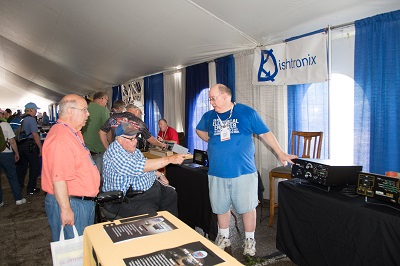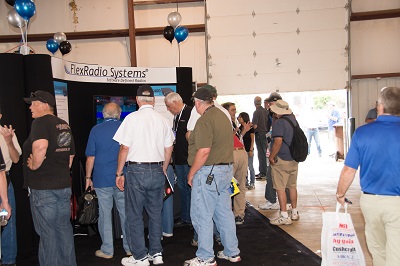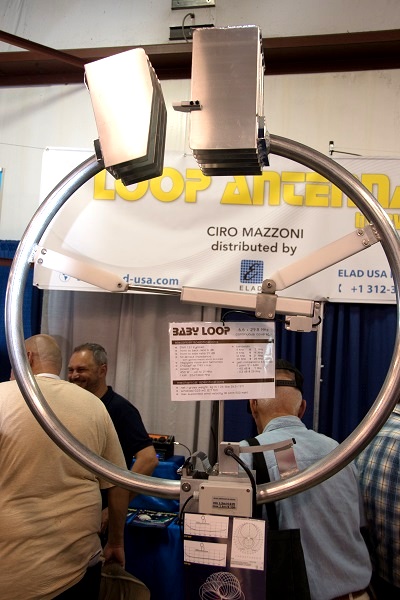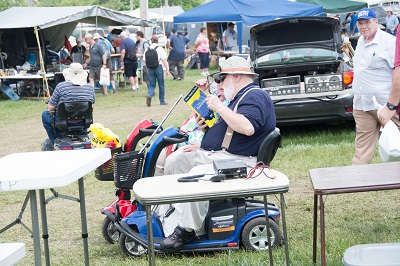 It should be noted that this year was the first Dayton
Hamvention hosted in the new venue at the Greene County Fairgrounds instead of
the Hara Convention Hall.
It should be noted that this year was the first Dayton
Hamvention hosted in the new venue at the Greene County Fairgrounds instead of
the Hara Convention Hall. Clearly some work needs to be done on traffic. While the drive from our hotel, same one used when at the Hara Center, was fairly short, the arrival in Xenia was horrible. We left about 7:10 am to arrive early and were in Xenia by 7:20, but then spent over an hour in traffic that appeared completely frozen. By radio we heard the Xenia police had asked that now traffic be routed around the town. When we finally arrived at the fairgrounds, parking was free and plentiful, but others who took the “official” suggestion to park in a remote lot then found they had a similar time riding the free bus. I heard one guy say he spent 2 hours getting in.
Inside, manufacturers were relegated to a few permanent buildings, or several large tents outside. None were air conditioned, and it was hot. All spaces, even the tents, were fairly dark inside, and the heavy rain the day before had flooded some tents, requiring some vendors who had put carpet down over the asphalt to have to just throw the carpet away. Vendors in the tents found things a bit crowded, too, and generally were not real happy with their surroundings in my limited observation. Folks inside seemed to do better…but it was pretty hot.
Outside there were a surprising number of food trucks, like you might find at a fair, and benches scattered around. The flea market Area was a real improvement over Hara, all on grass and comfortable to walk through. Most were on the infield of the horse track, but some had premium spots nearer the buildings and even a few trees for shade. However, the Saturday return following overnight rains made the parking area entrances real mud bogs and could be quite a challenge in 2WD cars. Reports from others said the flea market area got pretty mucky too, although we didn't venture there the second day.
Once at the park, getting a ticket, especially at the “Will Call” booth, was easy, but the line to enter was long waiting for the 9AM start time (above picture was 1 hour before gate opened). Shuttles, either tractor-drawn wagons or golf carts were plentiful, but it was never clear how to get one that wasn’t already full. That said, when we finally left we were offered a ride by fair officials from the distant flea market (but their cart could only hold one passenger) and did manage to catch a shuttle for the ride back by walking in a ways.
 A visit with Mike Dishop in the Ten Ten/Alpha booth
was interesting (see picture to right). He expressed frustration with trying to keep the company going
with all the inventory having been lost by previous owners, and small business unfriendly officials in Sevier
County TN where he wanted to remain, but his dedication in wanting to keep the
brand going was evident. He certainly recognized that he needed to get products
moving for sale and has, in fact got Alpha shipping new amps now. They had all
the latest rigs from Ten Tec on display including the Rebel/Patriot line, the
Eagle, and the Omni VII, but no date for manufacturing was mentioned.
A visit with Mike Dishop in the Ten Ten/Alpha booth
was interesting (see picture to right). He expressed frustration with trying to keep the company going
with all the inventory having been lost by previous owners, and small business unfriendly officials in Sevier
County TN where he wanted to remain, but his dedication in wanting to keep the
brand going was evident. He certainly recognized that he needed to get products
moving for sale and has, in fact got Alpha shipping new amps now. They had all
the latest rigs from Ten Tec on display including the Rebel/Patriot line, the
Eagle, and the Omni VII, but no date for manufacturing was mentioned. Flex
(picture to left) had a new rig that was essentially the 6300 with
a built-in, non-removable Maestro panel for about $200 less than the separate
pair. Reminded me of the Ten Tec Jupiter which was a built-in panel version of
the Pegasus many years ago. Still, a nice answer to the Icom 7300 family that is
developing around direct-sampling radios.
Flex
(picture to left) had a new rig that was essentially the 6300 with
a built-in, non-removable Maestro panel for about $200 less than the separate
pair. Reminded me of the Ten Tec Jupiter which was a built-in panel version of
the Pegasus many years ago. Still, a nice answer to the Icom 7300 family that is
developing around direct-sampling radios.Icom had a new rig, the 7610, which is an upscale version of the 7300, but allows remote operation by plugging its Ethernet port directly into a router, like a Ten Tec Omni VII. A very nice looking rig that takes advantage of 7300 users wanting to move up. They indicated they expected the new radio to be available in September.
Apache had a stand-alone front panel for the Anan SDR rig, similar to the Maestro for the Flex, but not capable of remote operation at this time.
Several loop antenna systems were seen, and one of the more interesting (picture below to right) were the products by I3VHF. One covered 6-29 MHz and
 the other
larger one covered 3.5-7.5 MHz. The higher frequency model was remarkably small
and tuned, remotely, but driving one half of the loop toward the other to
increase the mesh of the large capacitor plates at the top. Power handling was
around 450w, and more on 10m and the cost, with the controller was over $1800.
the other
larger one covered 3.5-7.5 MHz. The higher frequency model was remarkably small
and tuned, remotely, but driving one half of the loop toward the other to
increase the mesh of the large capacitor plates at the top. Power handling was
around 450w, and more on 10m and the cost, with the controller was over $1800. Another bright spot were some groups of kids in
STEM-based clubs excited about building robots, ranging from Lego units on
custom table-top courses to large machines designed to accomplish a specific
task most efficiently and win contests. We saw one running around picking up
wiffle balls and chucking them at basket goals (picture to left) . All the kids, from the
elementary to the high schoolers were eager to describe how they did the designs
and what they were interested in doing next. Their leaders mostly just beamed.
Another bright spot were some groups of kids in
STEM-based clubs excited about building robots, ranging from Lego units on
custom table-top courses to large machines designed to accomplish a specific
task most efficiently and win contests. We saw one running around picking up
wiffle balls and chucking them at basket goals (picture to left) . All the kids, from the
elementary to the high schoolers were eager to describe how they did the designs
and what they were interested in doing next. Their leaders mostly just beamed.We wore out in the early afternoon and headed out for a late lunch, but it was neat to see an active hobby. The day before the local news was brimming with stories about how Xenia’s population was doubling for the weekend and what was all this about. Hams were linking up with each other for eyeball QSOs, too. I heard one talking to another on 2m as we drove in saying “just look for the large middle-aged white guy carrying an HT”…right.
On Saturday afternoon, we found the crowds considerably less than Friday morning and were able to spend more time talking to several vendors about their products. The MFJ Remote Shack demonstration of their remote control of an ICOM transceiver, amplifier, and antenna rotator with cell phone DTMF tones was impressive both in ease of execution and the apparent ease of setup. This product is certainly a credible candidate for someone looking to add remote operation of his shack equipment when on the road.
How to compare the 2017 Xenia Hamvention with the 2014 Dayton Hamvention, which we also visited?
Attendee Comfort: The 2014 experience was in the venerable Hara Convention Center which was a large building complex with interior connections between the various building sections. As I recall, it must have been air conditioned as the temperature in 2014 was a great deal more comfortable. The 2017 Hamvention was housed in four open and non-air conditioned brown metal buildings and several large tent structures. Doors were open and all exhibitors had fans of various sizes to stay cool. Those fortunate enough to have exhibits near open doors seemed to benefit from breezes. Hara had no particular problems with temperature although some buildings seemed less well air conditioned.
Rest spots: In 2014, the Hara main hall had sloped event seating around the main hall's exhibits, offering a place for people to take a break and sit, along with the food court seating. The 2017 Greene Fairgrounds provided wooden fairground benches and aluminum bleacher seats to rest on. These were distributed throughout the area of the main exhibit buildings (not the tailgating section) and were conveniently available wherever you were in the walk through of the exhibits.. However, all 2017 seating was outdoors and the bright noon day sun made for slow roasting of the resting Hamvention attendees. It would have been worse except that the sky was partly cloudy and would periodically obscure the direct sunlight.
Food: Hara had a single large food court for getting a bite to eat, somewhat centrally located and which had to be transited through to get to exhibits on the other side, and this was somewhat troublesome from 1100 to 1300 time frame. Food wise, the 2017 offering was outside the exhibit halls, much more distributed and gave attendees a greater variety of food choices.
Transportation and parking: In both 2014 and 2017, we drove in early on Friday morning, in order to be parked and at the entrance doors when the gates opened for attendees. In both cases we succeeded. However, the 2017 approach to Xenia was agonizingly slow, moving 1 car length at a time for the last mile. I recall no particular traffic congestion in the approach to the parking fields at Hara. We never quite understood what was pacing that slow progress in Xenia, because the last 1/4 mile actually picked up and moved fairly quickly. Both the 2014 and 2017 local parking was in large grass fields but the 2017 experience seemed less well organized at 'quickly' parking the cars after they entered the fields. Both 2014 and 2017 had remote fields for overflow parking with busses to get to the Hamvention. In 2017, there were a good number of shuttles provided to get people from the local parking fields to the entrance gates. Shuttles consisted of six seat 'golf carts' and large tractors pulling wagons with bench seating, guard rails, and installed steps to get on/off. There was no such assistance to get from the parking fields at Hara.
 Personal carts: One of the notable aspects of
the 2017 experience was the proliferation of electric carts. It was
difficult enough walking around crowds that were clustering and talking with
each other or exhibitors, but the large number of carts aggravated that even
more. As the Ham community ages, this seems to be an increasing part of
the ham fest experience and it was very prevalent in 2017. The picture to
left was atypical only in the fact that both spouses had carts.
Personal carts: One of the notable aspects of
the 2017 experience was the proliferation of electric carts. It was
difficult enough walking around crowds that were clustering and talking with
each other or exhibitors, but the large number of carts aggravated that even
more. As the Ham community ages, this seems to be an increasing part of
the ham fest experience and it was very prevalent in 2017. The picture to
left was atypical only in the fact that both spouses had carts.Non-Ham Exhibits: The growth of non-Ham and non-technical tables has seemed to be increasing at the smaller ham fests, but that was not so prevalent in either the 2014 or 2017 Hamventions. The most notable exception was a fairly large exhibit of outdoor hanging chairs this year. One of the most enjoyable non-Ham, but still technical, offerings this year was the exhibit of Technical Challenge robots. This was really interesting to watch. Robot control was by various video game controllers connected to cell phones communicating to a cell phone on the robots. The robots tended to have wheel pairs at each corner but always mounted at 45 degrees to the both sides of the robot at the corners. It was fascinating to watch how the wheel pairs were driven to move the robots along a straight line in ANY direction.
Duration: About the same for 2014 and 2017. We started inside the entrance gates at 0900 and left a bit after 1400. If you truly looked closely at each exhibit and talked to a lot of vendors, you could easily stay 8 or more hours, stamina permitting.
Best time to attend: Both the 2014 and 2017 Hamventions were planned and executed to be present when the doors opened. However, this year, our return to the Hamvention on Saturday afternoon gave us a new, and positive. experience with attending later on the 2nd day. If we ever go back to Dayton (Xenia - ?) we may well plan to arrive later and let the early rush of attendees subside.
Summary of the Summary: It will be interesting to see how this first experience in Xenia plays out. It was our sense that a lot of vendors did not like being put into tents and not having air conditioned buildings. Will that impact vendor attendance in later years? And it is hard to truly give you a sense of the degree to which the Hamvention traffic impacted Xenia residents and businesses. Will Xenia want to work with the Hamvention organizers to work out the lessons learned for future Hamventions, or will they decide that it is too disruptive and seek to cut their ties after this experience?